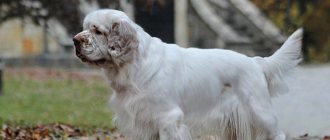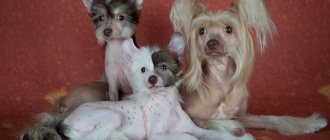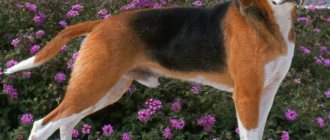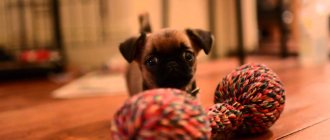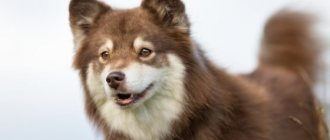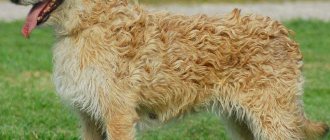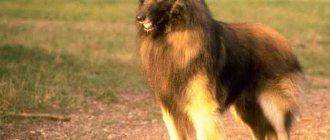- Pets
- >>
- Dog breeds
* Here is a photo of a typical representative of the Giant Schnauzer dog breed . You can send us photos of your animals by email, and we will post them on the website. Don't forget to send your pet's name.
Other breed names:
Giant Schnauzer
Video
* We invite you to watch a video about the Giant Schnauzer . In fact, in front of you is a playlist in which you can select and watch any of 20 videos about a given dog breed by simply clicking on the button in the upper right corner of the window. In addition, the material contains quite a lot of photos. By looking at them you can find out what a Giant Schnauzer looks like.
In this article:
|
Rate the material!
[Total votes: 1 Average: 5]
The Giant Schnauzer is an intelligent and efficient dog. Thanks to this, dogs often serve as police officers, bloodhounds, security guards - they have mastered many other professions. But they have a strong character and you need to find an approach to them, so as pets they are suitable only for those owners who want to have an independent dog.
History of the origin of the Giant Schnauzer
It is believed that they, like most other wire-haired breeds, are descended from herding dogs. The ancestors of the Giant Schnauzers lived in the south of Germany and were used not only as shepherds, but also guarded the houses and the owners themselves.
It is not entirely clear how closely related they are to the Schnauzers; it is known that they are related to pinschers - but at what point it appeared is no longer clear.
In the 19th century, Giant Schnauzers gradually ceased to be only peasant dogs. This is clearly evidenced by the fact that they can increasingly be seen in portraits of aristocrats of those times - by that time the breed was already taking shape in its main features. At the beginning of the 20th century, they began to participate in exhibitions, and international interest appeared in the breed.
Then they were called beer schnauzers due to the fact that the owners of Bavarian taverns often assigned them to carts with beer as guards. They were also sometimes called bear schnauzers, probably because they were used to hunt bears.
In those days, the formation of the breed was still ongoing: its representatives were very different from each other in size and color: they could be yellow, gray, black and white. In 1923, a standard for the appearance of the breed was developed, and with it its current name arose. At the same time, the first Giant Schnauzers appeared in the USSR, but at first they did not gain popularity.
Interesting fact: Most of the modern Russian Giant Schnauzers descended from two individuals brought to the Krasnaya Zvezda kennel in the early 1970s. In this kennel, work was carried out to improve the breed through crossing with dogs imported from Germany and the Czech Republic.
As a result, domestic Giant Schnauzers have good character and appearance, and are able to compete at international exhibitions. They are not among our most popular breeds, but they are quite common.
Giant Schnauzer - description of the breed
These are strong, fit dogs, the largest of the schnauzers. The height of an adult dog should reach 60-70 cm, and weight – 35-47 kg.
Breed standards:
- Large oblong skull, flat forehead, clearly defined transition to the muzzle;
- The jaws are large, 42 teeth, scissor bite;
- The ears are set high and slightly drooping. Previously, it was customary to stop them, now in Europe this procedure is prohibited, in Russia it is still often performed;
- The neck is muscular and wide, without folds;
- The back is short and powerful, the belly and sides are tucked in, making the Giant Schnauzer look slender. The croup is slightly sloping, protruding chest;
- The limbs are straight and parallel, set quite widely. The shoulder blades are inclined at an angle of 50°. Both hind and forelimbs should be sufficiently long and well developed, with cat-type paws. When moving, the forelimbs are thrown far forward, and momentum is imparted with the help of the hind limbs. The dog's movements are sweeping;
- The tail is short, raised, tapering towards the end. In Russia it is often stopped;
- The coat is very hard and short. The fur that grows on the muzzle is the most rigid. The undercoat is abundant.
Every deviation from the approved breed standards is considered a defect. Most are not too significant unless the dog has too many of them.
But there are also defects - these include severe defects and the following deviations:
- Malocclusion;
- Deviation in height of more than 4 cm from standards;
- Inconsistency with the breed;
- Deviations in behavior - cowardice, aggression, malice, excessive distrust.
Appearance
The Giant Schnauzer is a large, strong dog with coarse hair that forms thick eyebrows, mustaches and a beard on its head. Outwardly it is similar to the Black Russian Terrier. Sexual dimorphism is well expressed.
- Height at withers: 60-70 cm.
- Weight: 35-45 kg.
The head is proportional. The transition from the forehead to the muzzle is clearly visible and is emphasized by the eyebrows. The nose is well developed and black. The bridge of the nose is straight. Scissor bite. The ears are dropped, set high and turned forward, and can be cropped as standard. The eyes are set straight, dark in color, oval, medium in size. The eyelids fit tightly and are dry. The neck is slightly arched with a smooth transition to the withers.
The topline is slightly sloping. The croup is rounded. The chest is moderately wide. The tail tapers towards the end; according to the standard, it can be docked up to the third vertebra. The forelimbs are strong and spaced at a moderate distance. The hindquarters, when viewed from the side, are drawn back; when viewed from behind, they are set moderately wide, parallel. The paws are short and rounded. The fingers are well gathered into a ball. The claws are dark, the pads are elastic. Movements with good range, free, fast and elegant.
The coat is hard, thick and of medium length. The undercoat is thick. Longer hair on the eyebrows and beard is typical. The color can be pure black or pepper and salt. With the latter option, a dark mask must be worn. Clear, light markings are undesirable.
Ear and tail docking for a Giant Schnauzer
In 2021, the FCI General Committee decided that in countries where such operations are prohibited by law, dogs with docked tails/ears cannot be shown at FCI shows. Unless there is a legal restriction in a country, dogs of breeds that have traditionally been subject to tail/ear docking may be shown without restriction. On par with dogs whose ears and tails are of natural length. In the CIS countries, docking of ears and tails is not prohibited. The resolution is valid until 2014.
Risen's ears are cropped at the age of 3-4 months. Tails are trimmed in 3-5 days, so this should be agreed upon in advance with the breeder.
Popular colors of Giant Schnauzers
Two colors are recognized as standard for the breed:
- Completely black;
- Pepper and salt.
They are regulated, details such as shades, depth, halftones, and so on are clearly established. At the same time, with the first color, everything is relatively simple: the coat and undercoat should be black. Experts evaluate the depth of color and the absence of tan, “rusty” undercoat, spotting, and the like.
If none of these are present, the dog meets the standards. Over time, gray hair appears - its suitability for the age of the animal is also assessed. Black color is quite easy to evaluate; salt and pepper is a completely different matter. Gray Giant Schnauzers are very difficult to evaluate; many articles are devoted to this problem.
At first, it may seem that such dogs are simply ash-gray, and the inclusions of white in the coat are evenly distributed, and there are no other peculiarities in the color. But this is not so: with visible chaos, dark and white hairs are located in certain zones, which must be at the correct distance from each other.
This is what allows you to get the effect of uniform color, pleasing to the eye. There are also frequent deviations in which light and dark spots on the coat are easily distinguishable. There should not be such spots, and in addition to uniformity, there are other requirements for color: the ash tone should be intense, and the undercoat should be light pepper, with a soft accent.
Variations of color are possible, from dark steel to light silver, all of them are recognized as the standard. Giant Schnauzers should always have a dark mask on their face.
Disease Prevention
What will help prolong your pet's life:
- Love;
- Weasel;
- Warm;
- Care;
- Walk;
- A game;
- Freedom;
- Space;
- Vitamins;
- Vaccinations
- Cleaning;
- Castration;
- Sterilization.
- Home conditions. Owning a Giant Schnauzer is suitable for owners of private houses with a yard or a spacious apartment - the dog requires a lot of space. There should be an enclosure for the animal in the courtyard of a private house, but if it is not insulated, then in winter the pet must be brought home. The cold can make your dog sick. This breed is a watchdog. The dog is an excellent, loyal and brave guard. Keeping a dog on a leash or chain is undesirable; it affects its psyche. An apartment, house, or enclosure must be kept clean, just like the animal.
- Communication, care. The owner should not ignore the animal, deny it games or walks. The pet requires attention. The Giant Schnauzer needs grooming (daily brushing, combing out the undercoat), trimming (removal of dead hair), trimming fur and claws, cleaning teeth, ears, eyes, vitamins and vaccinations necessary for immunity.
- Nutrition. You should not feed your dog fatty foods - this will lead to gallbladder disease. You need to feed him premium dog food.
- Exercise stress. The pet requires an active lifestyle and freedom. Games and running (with or without a harness) are required for the pet to splash out its energy, otherwise it will suffer from obesity. This breed is smart and easy to train.
Character and habits of Giant Schnauzers
The main feature of representatives of the Giant Schnauzer breed is that they are true service dogs with a developed protective instinct. Therefore, while protecting the owner, they can be aggressive, but in the family circle they are very kind, especially with children. Still, the Giant Schnauzer recognizes only one person as its owner, and he will have to keep the pet strict at all times.
You can’t let him go: be sure to constantly remind him that he needs to eat, walk and sleep by the hour, otherwise the pet will become stubborn in other cases. He needs to be trained, and not to stop teaching new commands from time to time. You should communicate with him more often and simply.
They treat strangers with suspicion and are ready to attack even those who simply raise their voice at the owner. At the same time, they remember faces well and even recognize people whom they had previously seen only once and a long time ago. Those to whom the owner is clearly well disposed get used to very quickly.
Interesting fact: Training of Giant Schnauzers should be aimed at making them more obedient and restrained, and curbing their aggression. They learn with ease, but they tend to test the strength of the teacher, so at first they are often stubborn.
A Giant Schnauzer will only respect an owner who shows himself to be a real leader in his eyes, but who is capable of much with him. Still, you should not expect that after a period of training the dog will turn into a simple executor of the owner’s will: it will be stubborn from time to time all its life, and it will also need to be trained all its life.
It’s not because Giant Schnauzers are stupid, quite the opposite – they are very smart dogs, which is why they tend to doubt some commands. In addition, they often show cunning and may try to deceive their owner. To prevent this and interact well with your pet, you need to constantly communicate with him.
They communicate well with children and enthusiastically participate in children's games. Of course, it is undesirable to pull their beard once again, but a well-bred representative of the breed will not do anything even to a child who has decided to test his coat for strength. But adult dogs that have not interacted with children before may be an exception, so you should be careful with them.
Diseases
Giant Schnauzers lead an active life, so they get injured. But owners should also be prepared for the fact that these dogs are prone to the following diseases:
Take the Attention Test! Find 10 differences! (click right here!)
Find the answer Are you bothered by some problem or question? Enter “Breed” or “Name of the problem” into the form, press Enter and you will find out everything about the issue that interests you.
- Enteritis (plague);
- Epilepsy;
- Pancreatitis;
- Bladder infections;
- Joint dysplasia;
- Oncology;
- Conjunctivitis;
- Cataract;
- Obesity;
- Rabies;
- Hepatitis;
- Otitis;
- Dermatitis;
- Heart attack.
The owner of a Giant Schnauzer must monitor the health of the pet in order to begin treatment on time.
Interesting facts about Giant Schnauzers
Schnauze is translated from German as muzzle, and riese means big. Thus, the name of the breed can be translated as “big muzzle”. Giant Schnauzers are very smart, which helps in their training: after training, they can recognize gestures and remember their meaning, and easily learn commands. In an emergency situation, they can sometimes figure it out and begin to act much faster than a person - which is why rescuers value them so much.
Giant Schnauzers make excellent crime hunters and search engines, which is why they often serve in government departments in different countries. They are also in the civil service in Russia, albeit in much smaller numbers than German shepherds: they are in the army, police, Ministry of Emergency Situations - and everywhere they receive praise.
The ingenuity of these dogs can also be used in everyday life: they will gladly take children on a sleigh ride, which will also be entertainment for the dog, or carry out some other errands around the house. You can accustom a Giant Schnauzer to many tasks: for example, in one Russian family they trained their pet to carry water from the pump to the house. People's Artist of the USSR Yuri Nikulin was a big fan of the breed and kept two Giant Schnauzers at home.
Giant Schnauzers are one of the most numerous participants in the Schutzhund competitions held in Germany, with their help the working qualities of dogs are tested. As part of such a competition, they must first find the intruder, report him by barking, but not bite; if he tries to escape, stop him.
Pros and cons of Giant Schnauzers
Dogs of this breed have many advantages, which is why they are bred.
Let us highlight the most important of them:
- Intelligence and intelligence - thanks to their quick wits, they learn quickly, they don’t have to be told repeatedly not to do something. They understand the mood of the owner and do not bother him when he is not in the mood for communication;
- The qualities of a watchman and protector provide protection for both the owner and his property, and you can be sure that the Giant Schnauzer will try to fulfill its mission with all its might;
- Balanced – if a dog of this breed is well trained, it will not react to everything and will only attack those who truly pose a threat. When surrounded by family, he behaves calmly and even friendly, and quickly recognizes familiar family members;
- Friendly attitude towards children - understands well how children differ from adults, and allows them much more, does not respond with aggression to their antics. But it is worth noting that it is still better not to leave Giant Schnauzers alone with too young children, even well-trained ones - they can cause injury by accident;
- Loyalty - despite the fact that they can show character to the owner and be stubborn, even try to outwit him, and are not too inclined to flatter, they are very attached to the owner;
- Efficiency - thanks to the combination of strength and intelligence, they are able to perform various, even quite complex work, and show excellent results in difficult conditions;
- The ability to adapt - they can be kept both on the street and in an apartment, and in the second case they will remain healthy and vigorous, provided that they are walked often enough and for a long time. They behave calmly in the apartment.
The breed also has disadvantages:
- Like other guard dogs, Giant Schnauzers are quite aggressive, so they need to not only be trained, but also be kept under strict control at all times. In addition, the breed is also distinguished by its stubbornness and cunning, so such a pet will not allow the owner to relax - he will have to show his authority all the time;
- This dog's coat will require constant care, so be prepared to devote quite a lot of time to it;
- When living in an apartment, you will need to spend at least two hours walking every day, and they must be very active, so the owner will not be able to take a relaxing walk - this should be jogging or cycling.
Education and training
As an active dog, the Schnauzer needs strict treatment, but there must be a balance of strength and affection. The desire to dominate is in his blood. Any attempts to show aggressiveness or attacks must be controlled by the owner.
Socialization in Schnauzer dogs is early. It is necessary to familiarize them with the living conditions in a city or village, acquire familiar dogs with whom you can play and run.
All schnauzers get along well with other pets. They won't mind a cat or another dog. Good companions who can be trusted with security and not be afraid of strangers entering the house.
It is easy to train, quickly learns basic commands, and does not require a special training course. The purpose of the breed is protection and hunting. Additional factors are the ability to entertain and bring joy. This is not just a little dog. A real miniature protector of the owner, family, children.
Breeding Giant Schnauzers
If you are the owner of a male dog, you should immediately decide whether you will breed him. For the dog himself whether they exist or not is not so important. If you walk your pet often and exercise it, then there will be no problems even if there are no matings. Therefore, the key factors here are: how much demand he has, whether he has success at exhibitions, whether his nervous system is stable, and the like.
It is more difficult for owners of bitches, because when puppies appear, they will face many new problems. There are often many puppies in a litter - up to 10-12, you need to take into account that all of them will need a lot of space, as well as funds for food and medications. Puppies will need to be kept for at least one and a half months, and some often stay for up to 3-4 months.
It will be much more difficult for beginners to place puppies than for experienced breeders with a reputation, especially if they choose owners and not give them away to just anyone. Puppies grow quickly and, if the adult Giant Schnauzers behave calmly in the house, the young ones play and frolic - and with each week their games become more and more destructive for the home.
On the other hand, this can also be an opportunity to earn money, but only if both parents meet all breed standards and the mating is registered - you won’t get much for puppies from an unregistered mating.
Bitches come into heat once, or more often twice, a year. You can tell about its imminent onset by the changed behavior of the pet: within a week or two there is a decrease in performance, absent-mindedness, and she marks her territory more often.
Mating is carried out twice with an interval of one and a half to two days. Pregnancy lasts two months or a little longer. Typically, with more puppies, the gestation period is shorter. The approach of childbirth is indicated by the dog's search for a secluded place for birth. It is better if the owner prepares it himself.
This should be a draft-free place, calm, warm and shaded. During the first birth, it is worth staying close to the dog in case of complications. If the process takes longer than an hour, and you have little experience, you need to call a veterinarian.
Caring for Giant Schnauzers
You can keep a Giant Schnauzer both in a private house and in an apartment. Of course, the first option is preferable, but a dog can only live outside when it’s warm. It is also important that they are not kept in closed enclosures, much less on a chain. The best option: an outdoor enclosure with a canopy and a booth inside.
During the winter, you can leave your pet outside only if there is heating, otherwise you need to take him into the house. Even in the warm season, it is better to take dogs over 8 years of age home at night, except during the hottest weeks - otherwise they will get colds in their kidneys or joints.
Interesting fact: Although Giant Schnauzers are large, they do not take up much space in the house and are not inclined to frolic too much, turning everything around: you just need to provide them with a quiet corner and regular walks. This item is mandatory for dogs living in the house; walks must be carried out at least twice a day and be long enough.
For puppies this is at least half an hour, for adult dogs an hour, or better yet two. During walks, they need to be let off leash in deserted places so that they can run around calmly. Walks should be as vigorous as possible; a slow pace will not suit the dog, so it makes sense to take a scooter or bicycle.
They also need training - because of this, it is better to keep dogs of this breed for people who are full of energy; for the elderly, they can turn into a burden. Moreover, the Giant Schnauzer also needs other care, primarily for its coat. It will need to be combed every day and cut every two months.
A well-groomed coat should not have a characteristic dog odor - if it is present, then you need to take better care of it. Trimming is mandatory so that hair does not fly around the apartment after shedding, and after the shedding hair is removed, you need to treat damage to the skin with chlorhexidine.
Trimming should be done for the first time at 6 months, and then every six months. For washing, use tar or sulfur shampoo; this can be done not very often, if necessary. After the dog eats, you need to wipe the hair on its face, and if it is oily, then wash it with soap - this minimizes the risk of the fungus spreading.
If your pet is accustomed to swimming, then before the start of the season he needs to be vaccinated against fungus and also start using antifungal shampoo. Ears, nose, teeth, claws and eyes are taken care of as usual. It will be useful to pluck the hair growing in the ear funnel so that it does not collect wax.
Care and maintenance
Even if the dog is not miniature: it will be able to live perfectly both in the enclosure of a country house and in an apartment. The exception is if the living space is too small. The dog will not take up much space in the house and will not turn everything upside down. Optimal conditions for the breed are a spacious courtyard of a private house. This is where your four-legged friend will be able to run freely and interact with people.
If a dog has an outdoor enclosure, then it should be well protected from the weather: have a canopy, a plank floor, and an insulated booth. If the winters in the region are harsh, then you should definitely take your pet indoors to avoid illness. And remember that by placing your dog outside, you are depriving him of necessary frequent human contact. And this is a condition for the formation of a calm character.
Putting a Giant Schnauzer on a chain is simply an insult to the animal’s pride and temperament. If there is a need to limit the dog's movement, it is better to lock it in an enclosure or in a room. Remember that this breed requires constant and fruitful walks. You need to play and talk with her. Insufficient activity often leads to weight gain and other health problems.
It is interesting that such dogs almost do not smell like “dog”. However, their coat will require careful care:
- at the end of each meal, be sure to wipe the animal’s face;
- periodically remove excess hair around the eyes, above the upper lip, between the paw pads;
- the dog should be constantly scratched with a special brush;
- several times a year you need to have a professional haircut to remove tangles;
- Keep your ears and eyes clean.
Interestingly, Giant Schnauzers practically do not shed, and their fur does not shed. To improve the structure of the coat, burdock oil should be used. It is gently rubbed into pre-washed and dried hairs.
Pets should be bathed as needed. It will be enough to do this 1-2 times a year. But the face should be wiped constantly to keep it clean and tidy.
Examine your pet's eyes weekly. It is recommended to visit a doctor once every six months. Remember that Giant Schnauzers are susceptible to ophthalmological diseases.
You should also check your pet's ears once a week. It is necessary to remove dust and dirt, as well as excess hair that may block the ear canal. The claws are trimmed as they grow. Due to prolonged loading, they wear down on their own.
You should take your Giant Schnauzer for a walk at least twice a day. For puppies, it should be 30 minutes, and for adults – an hour. It is best to walk a young dog on a leash. In calm and safe places you can let her go. If your pet is interested in what he is doing, call him to you or feed him a treat. If there is zero reaction, the leash is simply fastened.
Remember that adults living in an apartment are not happy with too sluggish walks. The best option would be to combine your own sports activities with walking your pet. For example, you can ride a bicycle or scooter, and the Giant Schnauzer will be happy and eager to run after you. You should not keep your puppy indoors until she is 4 months old. Otherwise, you risk raising an antisocial animal.
Don't forget about vaccination. The first vaccination should be given at 2 months. Repeated – after 21 days. Such comprehensive protection will protect against plague, parainfluenza, hepatitis, and parvovirus enteritis. At six months, a rabies vaccination is given, as well as a third complex vaccine against infectious diseases. After 12 months, the animal is vaccinated annually.
Caring for and maintaining a Giant Schnauzer does not cause much trouble if you accustom your baby to all procedures from early childhood. Little time is spent on hygiene, and walks become a pleasure when the dog is well-mannered and obedient.
Diet of Giant Schnauzers
The Giant Schnauzer menu is based on:
- Raw meat, if possible lean, with the exception of lamb and chicken;
- By-products;
- Dairy products;
- Vegetables;
- Cereal porridge.
Young pets without problems with the digestive system should also be given marrow bones - they contain a lot of calcium.
It is important to supplement with vitamin-rich plant foods such as:
- Greenery;
- Fruit salads;
- Dried fruits.
First of all, food from the owners’ table is harmful to Giant Schnauzers; it should not be given to them. Do not feed him fatty, salty, spicy and sweet foods; it is not advisable to give your pet baked goods. You should not feed him river fish or grains, or give him too much protein food.
For example, meat should be combined with herbs, fruits or porridge, but not with fish or eggs. There is also no need to cook meat; raw meat is much healthier. It should not be overly crushed either. Before giving meat to a dog, it must be frozen. Finally, even with a varied menu, do not forget about vitamin and mineral supplements.
When buying a dog, find out what the breeder fed it, and at first try not to change its diet too much. Immediately make a choice between dry food and natural products, and in the future stick to one. You should not combine both. If you choose dry food, stick to one brand.
Sometimes Giant Schnauzers may develop an allergy, in which case it is worth not only excluding from the diet the product that triggered it, but also taking your pet to the veterinarian to review its diet: it should become much stricter, otherwise the allergy may eventually appear to other products.
How to choose a Giant Schnauzer puppy?
It is best to purchase a puppy that has reached the age of 1.5-2 months. At this time, their bite is already forming, as the fangs are erupting. Dogs at this age are well socialized and can quickly get used to their owner.
You should purchase a puppy from a specialized nursery or from dog breeders with a good reputation. It is necessary to carefully study the pedigree of the animal and clarify the presence of cases of diseases in it that can be inherited. If the puppy shows increased aggressiveness, it is better to refuse to buy it, because... This behavior is not typical for these dogs.
The puppy must be well-groomed. The average weight of individuals at 1.5-2 months is about 3 kg. The animal should have a moist nose and shiny eyes. You should pay attention to your back. It should be without a hump. The animal's body should be compact and proportional. Puppies have a hard coat. It is better if there are no gray or white spots on the body. When purchasing a puppy, you need to check for the necessary vaccinations and documents.
Diseases and health problems
The health of dogs of this breed is strong and if you keep the Giant Schnauzer outside or walk it regularly, exercise it, feed it properly and treat it promptly, it will most likely live to be 10-12 years old. But even in this case, some diseases to which they are predisposed may appear. For example, these are cataracts, pancreatitis, melanoma.
The kidneys are at increased risk - they need to be especially protected, otherwise treatment will take a long time and be difficult. The second common misfortune is volvulus. To prevent this from happening, you need to feed your pet in smaller portions and let him rest after eating - time must pass before physical exercise.
The main symptoms of bloat are vomiting and noticeable swelling of the abdomen, difficulty breathing and severe tension in the dog's hind legs. If they appear, then you can’t hesitate: call the veterinarian immediately, because if you don’t get help, your pet will simply die.
Skin allergies are common. All schnauzers are hypersensitive to parasites and frantically gnaw them out of their fur. As a result, even a couple of fleas can seriously damage it, so you need to pay special attention to protecting your pet from them.
Another cause of allergies can be a lack of protein. It begins if there is little protein in the dog’s diet, so you should monitor its balance.
Hip dysplasia in Giant Schnauzers does not occur as often by the standards of large breeds, but it still happens. It occurs more often in old dogs, but with poor heredity it can also occur in young dogs. You should be wary if your pet begins to play less willingly, limp, or get tired faster than before.
